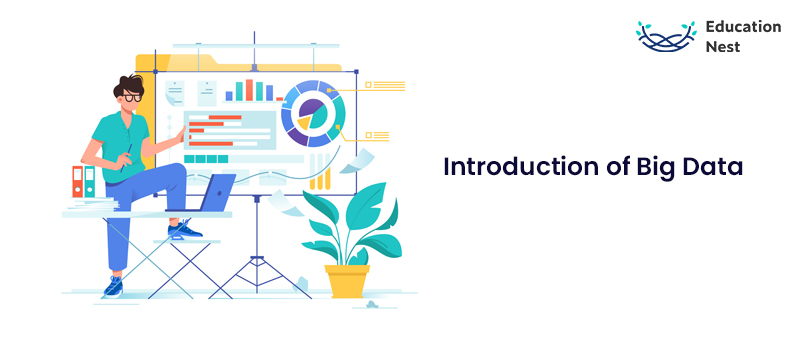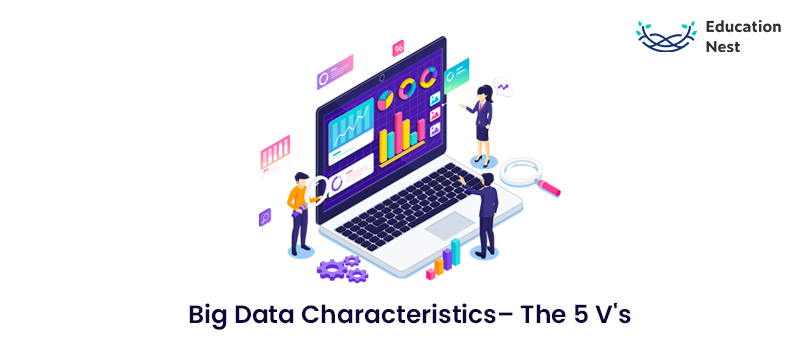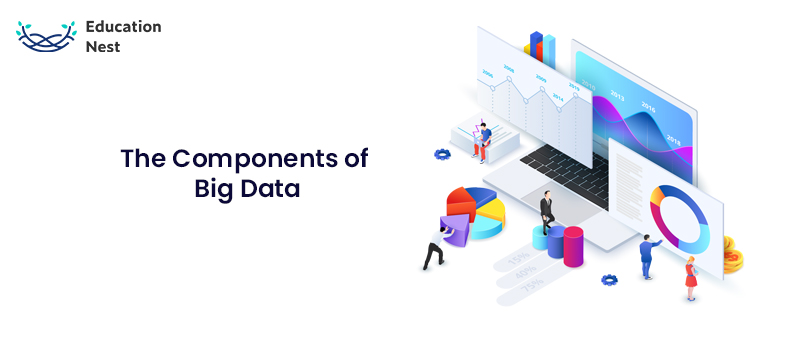The field of Big Data is one of the most rapidly expanding in the world. It’s the process of collecting and analyzing enormous quantities of data to draw conclusions and develop plans for improving a company’s many functions. Big data is a form of general idea with many benefits. This is why businesses in numerous industries are focusing on implementing this technology. One must become well-versed in the key characteristics of Big Data to comprehend it correctly. Learning about Big Data analytics’ defining features can also help you grasp its more complex ideas. The following article will cover big data’s definition, components, and 5Vs.
Let’s begin with an introduction to Big Data.
Introduction of Big Data

The phrase “Big Data” has become more popular in the computer industry. You’ve likely heard about Big Data if you’ve been following recent developments in your field. Many organisations—from governments to corporations to healthcare providers—are investing in Big Data projects to boost efficiency and expand.
Big Data facilitates the efficient use of massive datasets by businesses and other institutions. It lets firms see patterns and connections that would be hard or impossible to see with more traditional tools for processing data. There is a significant need for experts in big data analysis. To succeed professionally in this area, you must first learn the basics and get acquainted with big data characteristics.
What exactly is Big Data?
- Big Data refers to studying and learning from massive data collections.
- Data sets that include such information and continue to develop exponentially are another meaning of the phrase.
- This data defies the capabilities of any currently available data management system because of its sheer size and complexity.
- Big Data can be seen in action in several situations.
- Business operations across various sectors, from social networking sites to online retailers, create and use data to better serve their customers.
Data mining, analysis, storage, visualization, etc., are only a few of the many operations that make up big data. “Big data” describes aggregating all the processes and technologies we employ in this context.
Moving forward, Let’s discuss Big Data’s characteristics, also known as the 5 V’s of Big Data.
Big Data Characteristics– The 5 V’s

Volume: The term “Big Data” implies massive information. Big Data is the term for the enormous amount of information created daily by businesses, machines, social media sites, networks, and people’s actions.
Nearly a zillion messages, 4.5 billion “Like” button clicks, and over 350 million new postings are submitted to Facebook every day. Technologies for “big data” can process massive data sets with ease.
Variety: Data acquired as part of Big Data projects can come in various formats, including structured, unorganized, and semi-structured information. In the past, data was gathered just through databases and spreadsheets. Still, nowadays, it may be sent in various formats, including PDFs, Emails, audio, Social Media postings, photographs, videos, and so on.
Veracity: The veracity of the data refers to its dependability. It provides several options for data filtering and translation. The technique of effectively managing and manipulating data is called veracity. The use of Big Data for corporate growth is equally crucial.
Value: Big data can only be helpful if it contains anything of value. Information is not what we are dealing with or storing. We store, handle, and analyze data that is useful and trustworthy.
Velocity: When compared to other factors, velocity is crucial. Velocity is what makes data creation happen in real time. It connects incoming data sets’ velocity, change rate, and activity spikes. Big Data’s primary focus is on providing high-demand data on time.
In big data, velocity is the rate at which information is generated by various means (e.g., program logs, business operations, networks, social media, sensors, mobile devices, etc.).
After learning about the characteristics of Big Data, let’s talk about its components.
You Must Watch: An Informational Guide to Big Data Analytics
The Components of Big Data

Ingestion:
A data set is “ingested” or taken through collecting and organizing it. You can use the ETL (extract, transform, and load) method. You’ll need to figure out where your data came from, decide how to collect it (batch or streaming), and start cleaning, massaging, and arranging the raw material. You are responsible for the exact process of data collection and the transformation of enhancing that data.
Storage:
After collecting the data you need, the next step is to put it away. The ETL load procedure is the last step you’ll complete here. Depending on your needs, you might use a database system or a data lake to keep your data safe. That’s why, before beginning any big data process, it’s crucial to have a firm grasp of the organization’s end objectives.
Analysis:
The next step in the big data process is to evaluate the data and draw conclusions that will help your business. Big data analytics can be broken down into four main types: prescriptive analytics, predictive analytics, descriptive analytics, and diagnostic analytics. In this step, you’d examine the data with the help of AI and machine learning techniques.
Consumption:
The big data process is complete at this point. After you have completed your data analysis and discovered the insights, you can share your findings with others. When communicating with a non-technical audience like stakeholders and project managers, it is essential to use data visualization and storytelling techniques.
Lastly, we will look at a few advantages of Big Data.
Several Advantages of Big Data
In a business setting, Big Data can provide numerous benefits. Here are just a few of the most important ones:
Improved Decision-Making
Organizations can save time and effort with the support of big data initiatives, allowing them to make more educated choices. They might change their plans based on information they get from other places, such as social networking sites and search engines. When businesses use big data, they can see patterns and trends that they wouldn’t have seen before. This helps them make a lot less expensive mistakes.
Helping Customers with Data
Customer service is another area where big data could have a big impact on all industries. Companies are abandoning older methods of gathering client input in favour of more modern, data-driven approaches. Businesses may better understand client input and respond to their needs using these technologies.
Improved Productivity
Big data is used by businesses to find their vulnerabilities. Then, these findings are used to fix the problems encountered and improve business operations. With the Internet of Things (IoT) and robots, for instance, Big Data has dramatically aided the industrial industry in increasing efficiency.
Decision-Making in Real Time
Big Data has revolutionised various fields by providing real-time monitoring, such as managing inventory, supply chain management, anti-money laundering, or fraud prevention in banking and finance.
To summarise, big data is one of today’s most in-demand technologies. All sorts of businesses are investigating the potential of Big Data to help them improve their processes, reach more consumers, and stay ahead of the competition. Understanding the characteristics of big data is the only way to learn how to use and apply it correctly.
If you’re someone wanting to build a career in Big Data, you must enrol in big data courses.
